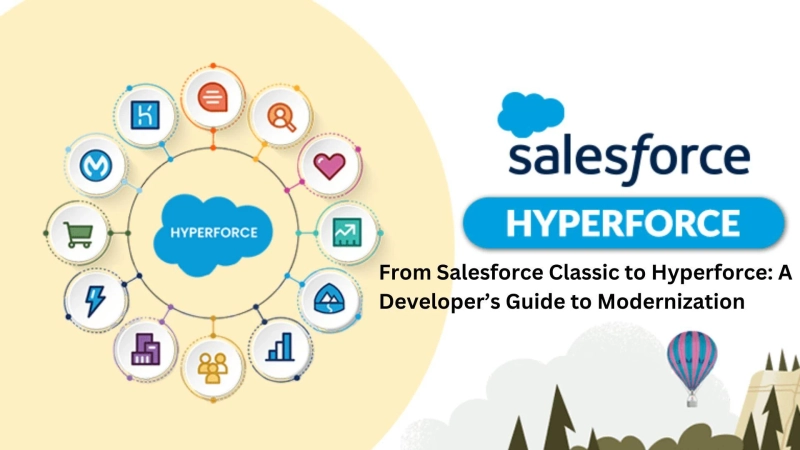Often overlooked, Salesforce Hyperforce was one of the key highlights of Dreamforce 2020. Since then, it hasn’t been in the limelight until now, when organizations are looking for a better data architecture in the Salesforce ecosystem. So, what exactly is Hyperforce, and what are Salesforce's ambitions with it? Hyperforce is an architectural improvement to Salesforce’s platform and is tailored for the public cloud. It brings a host of benefits, including scalability and a global reach. Let’s dive in.
What Is Hyperforce?
Hyperforce is a next-generation software that offers you more control over data residency and improves privacy and security. This is big in terms of Salesforce’s infrastructure. By shifting from private data centers into a partnership with public cloud providers like Amazon Web Services (AWS), Salesforce aims to ensure full compliance. This move allows Salesforce to continuously invest in and enhance its Customer 360 products and features, while offering improved Salesforce development services.
Advantages of Salesforce Hyperforce
Hyperforce empowers customers situated anywhere in the world to store their crucial data as per regulations specific to their industry, company, or geographical location. Here are some important advantages businesses can look forward to by migrating to Hyperforce with the help of Salesforce development services.
Scalability
The Hyperforce architecture is designed to grow alongside your business, processes, and users to meet the changing demands. This implies that you can easily scale up or down based on your requirements without worrying about any infrastructure limitations.
Security
Hyperforce is built with the concept of Zero Trust architecture and includes least-privileged encryption and control of customer data at all times. This protects your data from unauthorized breaches and access and maintains the highest security standards.
Data Residency
Hyperforce offers you full control of data residency and compliance, and empowers you to continue operating globally with improved speed. This flexibility ensures that your data is stored in compliance with local regulations, offering you peace of mind.
Privacy
Hyperforce assures permanent control mechanisms and data transparency. This allows you to get clear visibility and control over how your data is used and accessed. You also get access to robust privacy controls and audit capabilities that ensure compliance with privacy laws.
Agility
Although downtime may still be there for org migrations or major upgrades, Hyperforce improves agility by eliminating downtime for releases and routine maintenance. It also offers faster development environments and new interoperability through AWS. This empowers you with a more responsive system that makes way for faster updates and easy integration with other systems.
Do You Really Need to Migrate to Hyperforce?
Now that you’ve understood what Hyperforce is and what advantages it offers, let’s address whether it is really necessary to migrate to Hyperforce. The answer is “Yes”. Eventually, Salesforce will sunset its existing architecture and operate on Hyperforce. This qualifies your org for data migration and highlights the importance of preparing in advance. Hence, you might need to leverage Salesforce development services to effectively support this transition.
How to Modernize Your Salesforce Environment with Hyperforce
Transitioning to Hyperforce is a significant step in modernizing your Salesforce environment. Here are the important steps that you should follow for an easy migration.
- Assess Your Current Setup
Evaluate your current Salesforce Classic environment. Review existing customizations, integrations, and data structures that may be impacted during the migration. This will help you comprehend the scope of the migration and plan accordingly. You might want to document each dependency and create an inventory of your existing setup.
- Use Hyperforce Assistant
Salesforce Hyperforce Assistant is your best friend to guide you through the migration process with org-context verification checks, best practices, and recommendations. It helps you spot potential issues before they arise and gives informed advice to ensure a smooth migration. Streamline your preparation with the automated readiness checks of Hyperforce assistant.
- Update Hard-Coded References
Ensure that there are no hard-coded references, like 'na12.salesforce.com', in your code. Replace them with generic, non-instance-specific URLs to ensure functionality post-migration. Scan your codebase using tools like Salesforce Optimizer to identify and update any hard-coded references.
- Enhance Security Measures
Establish powerful security protocols, such as updating DNS settings for custom domains and configuring email deliverability settings to ensure communication flows well. This would include setting up protocols like DKIM, SPF, and DMARC to improve email security. Review your access permissions and ensure that the least-privilege access control principles are in effect.
- Test in Sandbox First
Use sandbox environments before full deployment to test the migration process. This helps identify and solve potential problems without affecting your live environment. Perform thorough testing on every integration and data flow. This will ensure that they are running flawlessly in the new environment. Do various rounds of testing to catch any issue that might come up.
- Engage Stakeholders
Establish an open line of communication with all stakeholders, including IT and end users, for an efficient migration process. Regularly update all stakeholders with progress reports and potential impacts on their workflows. Offer training and resources to help them adapt to the new environment. Create a method for ensuring prompt addressing of concerns or issues. A Salesforce development company can help you execute the above-mentioned steps securely and quickly to ensure an effective transition to Hyperforce.
Conclusion
In case you haven’t explored Hyperforce yet, now is the best time to start. Soon, all orgs will transition to this new infrastructure. The key goal is to boost agility and provide more options for data residency. By adhering to a structured approach and leveraging Salesforce development services, you can ensure a smooth migration.


